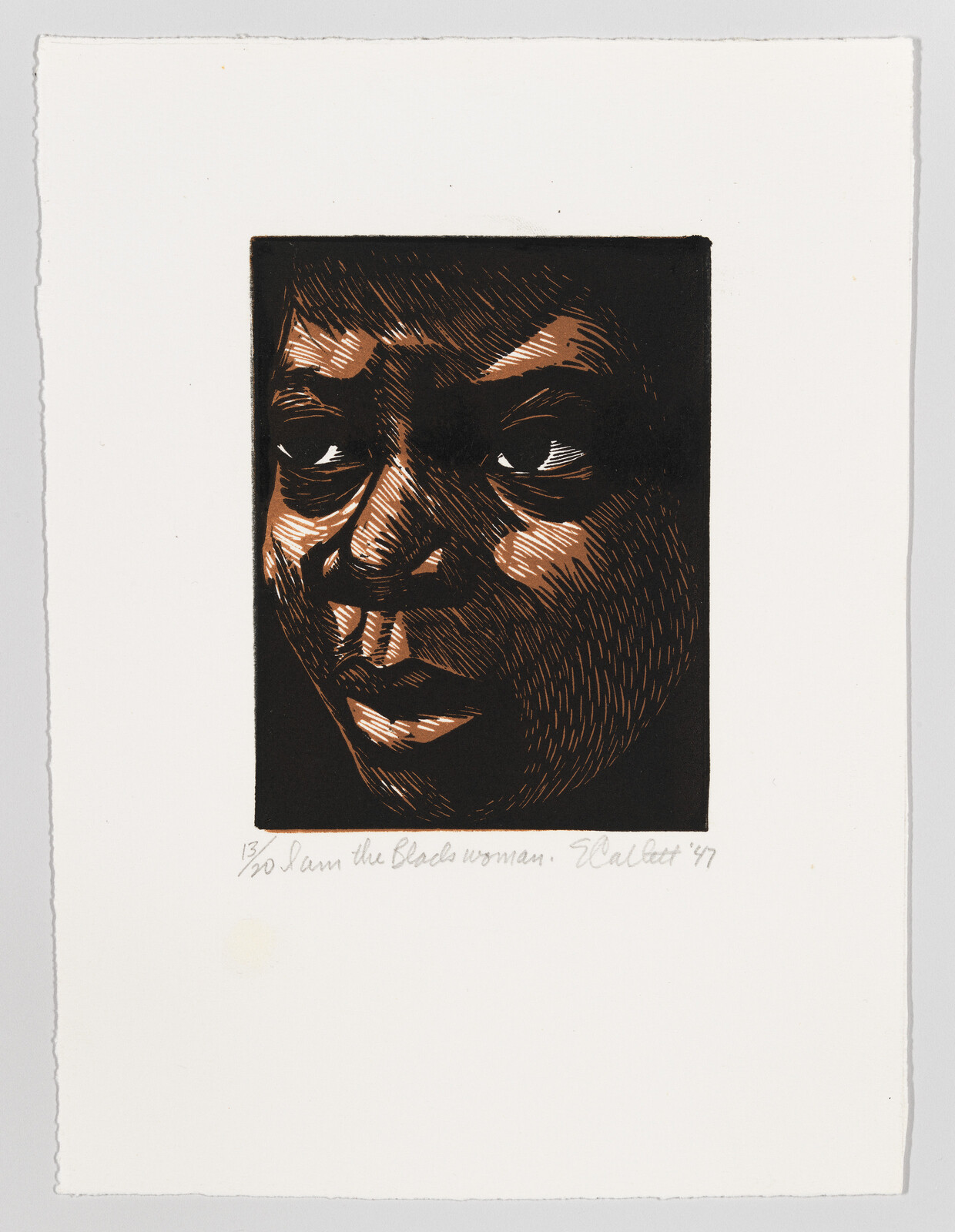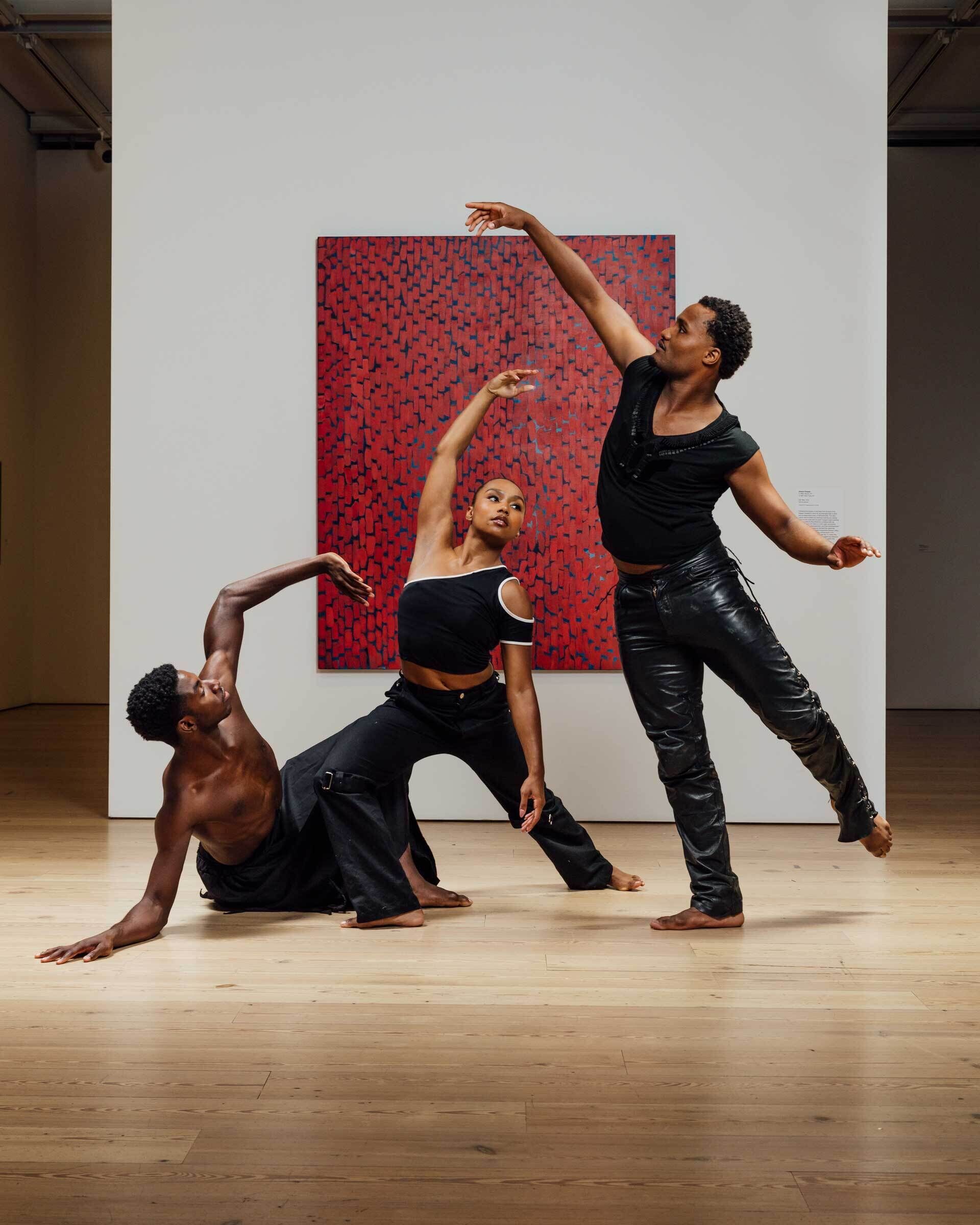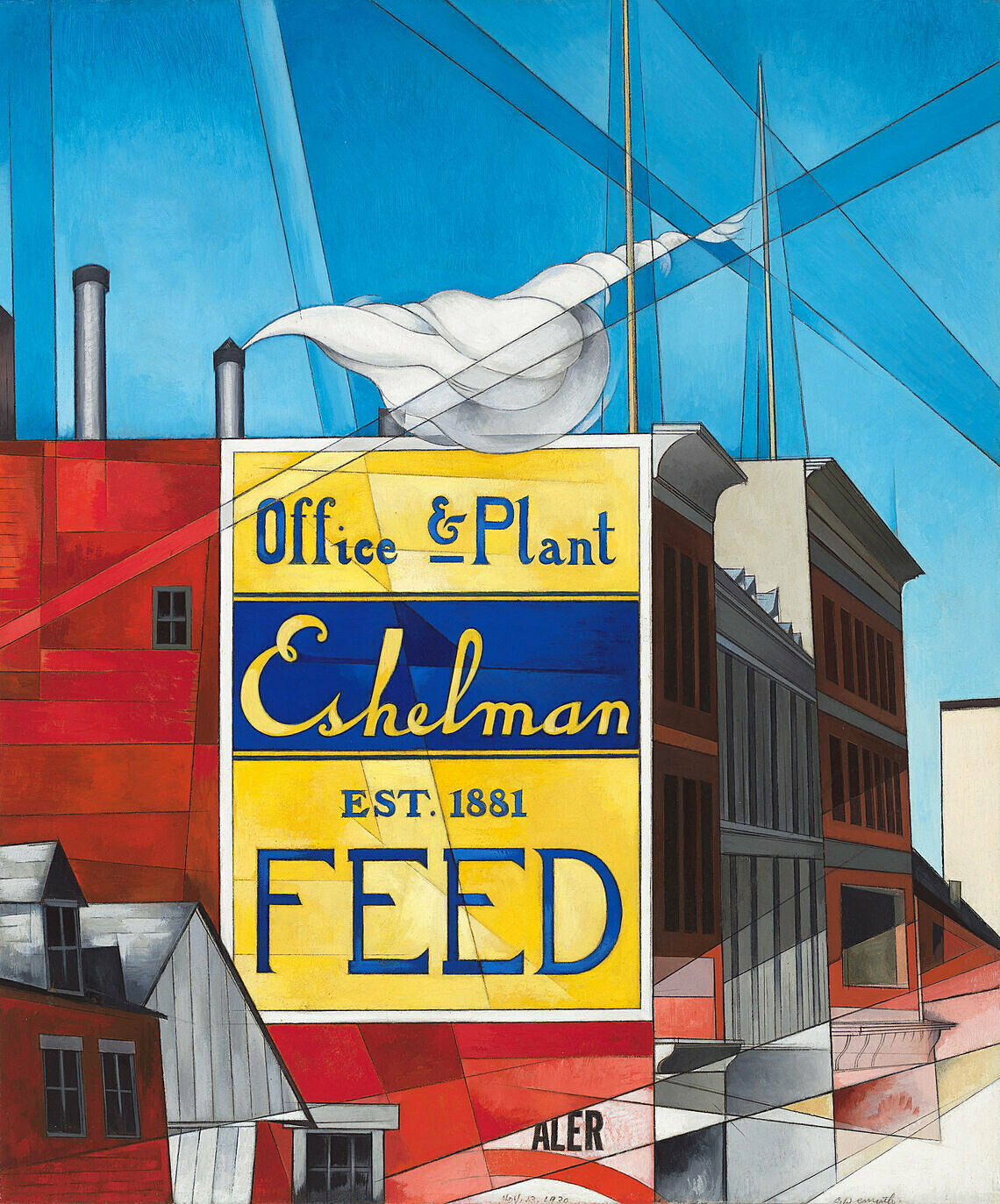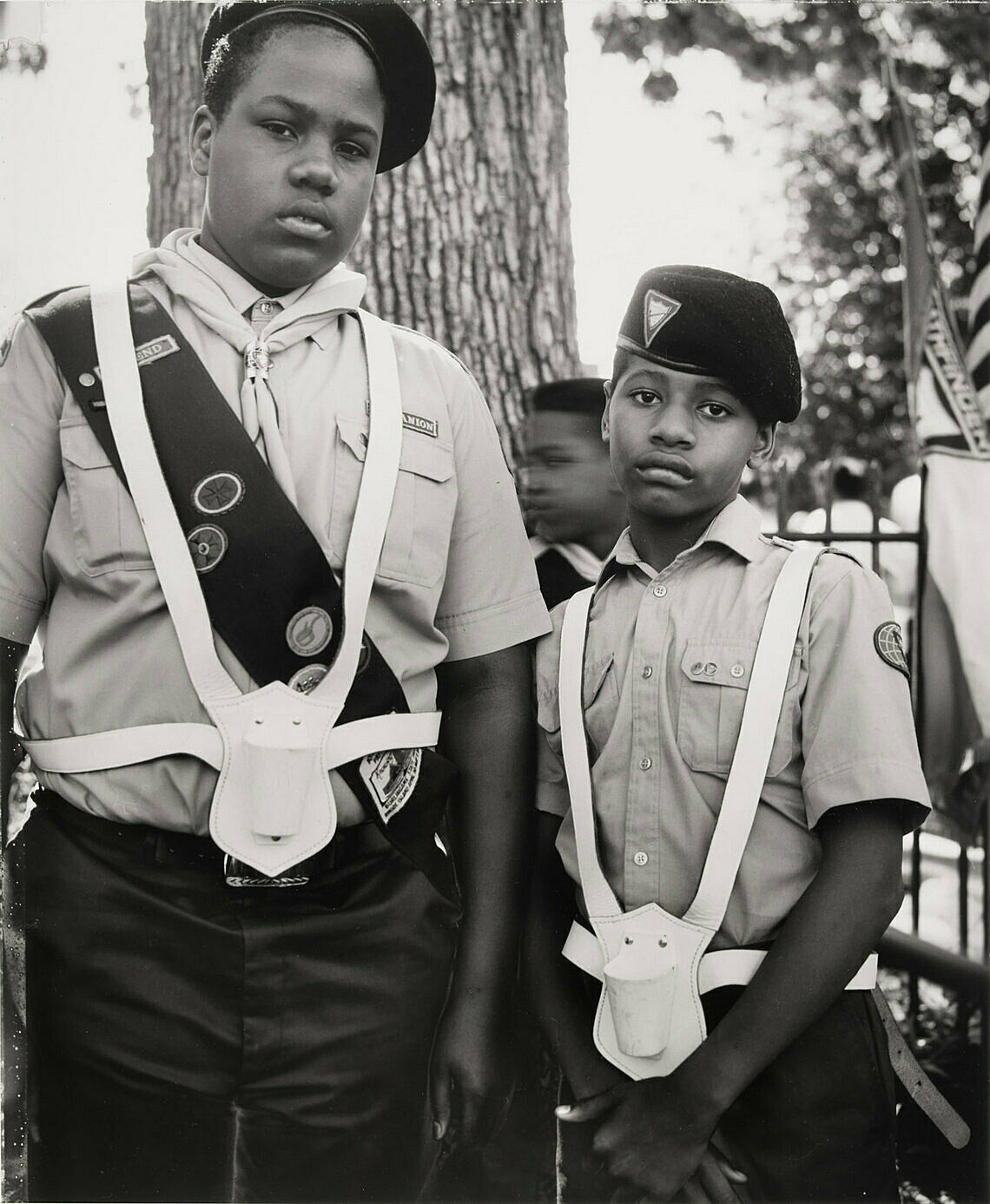Not on view
Date
1947, printed 1989
Classification
Prints
Medium
Linoleum cut
Dimensions
Sheet (Irregular): 10 1/8 × 7 9/16 in. (25.7 × 19.2 cm)
Image (Irregular): 5 3/16 × 4 in. (13.2 × 10.2 cm)
Accession number
95.189
Series
The Negro Woman, 1946-47 (re-titled The Black Woman, 1989)
Edition
13/20 | Second print run
Publication
Printed by Robert Blackburn Printmaking Workshop
Credit line
Purchase, with funds from the Print Committee
Rights and reproductions
© Catlett Mora Family Trust / Licensed by VAGA at Artists Rights Society (ARS), New York
Audio
-
Elizabeth Catlett, Prints
In Where We Are (Spanish)
0:00
Elizabeth Catlett, Prints
0:00
David Breslin: Elizabeth Catlett realizó esta serie de grabados llamada I Am the Negro Woman, en 1947, en su taller en la Ciudad de México.
Narrator: David Breslin es el Curador Familia DeMartini y Director de la colección.
David Breslin: Esta serie de obras son grabados sobre linóleo que muestran a personajes, como Harriet Tubman, Sojourner Truth y Phyllis Wheatley, y la idea de que su labor —ahora famosa labor de mujeres negras— debe ser celebrada, vista y convertida en un modelo a seguir. Como parte de esta serie también hay obras dedicadas a “mujeres desconocidas” y al trabajo invisible —bien fuera en el hogar, en los campos o en las fábricas—, una labor que pasaba inadvertida y que nadie consideraba heroica. La propuesta de Catlett era no sólo celebrar a figuras ejemplares como [Sojourner] Truth, sino celebrar también el trabajo diario de las desconocidas, de aquellas que realizan su trabajo sin recibir atención alguna.
-
Elizabeth Catlett, Prints
In Where We Are (Kids, Spanish)
0:00
Elizabeth Catlett, Prints
0:00
Mark Joshua Epstein: Bien, estamos observando una serie de grabados de la artista Elizabeth Catlett. Estos grabados fueron realizados entre 1946 y 1947, y originalmente llevaban el nombre de I am the Negro Woman, que más adelante cambiaría a I am the Black Woman, para reflejar el cambio de vocabulario en inglés de la época. Me pregunto, en general, ¿qué les llama la atención sobre estos grabados que ven en la pared?
Estudiante 1: Bueno, pareciera como el camino de los negros hacia la libertad; comenzaron siendo esclavos pero fueron avanzando. Se ve a Harriet Tubman ayudándolos a escapar hacia el norte.
Estudiante 2: Después la situación mejoró un poco para la gente negra porque se prohibió la esclavitud. Luego veo asientos de autobús “solo para personas de color” y sé que eso fue más adelante, cuando había segregación. Es como una cronología pero con imágenes.
Mark Joshua Epstein: Concentrémonos en esta obra sobre Harriet Tubman. Me pregunto qué saben ustedes acerca de su historia.
Estudiante 1: Bueno, era conductora de algo llamado el ferrocarril subterráneo.
Estudiante 2: “Subterráneo” es también una metáfora; no significa necesariamente que estuviera bajo tierra en realidad, sino que significa que era algo secreto, y ella conducía a los esclavos hacia la libertad, primero a Pensilvania, donde la esclavitud no estaba permitida. Luego tenían que ir hasta Canadá.
Estudiante 1: Harriet Tubman había sido esclava; trabajaba en una plantación, pero escapó. Fue muy osado de su parte volver y ayudar a tantos otros esclavos.
Mark Joshua Epstein: Elizabeth Catlett consideraba que muchas de estas personas que se ven en sus grabados eran héroes. Mezcla héroes de la historia de los Estados Unidos, como Harriet Tubman, con personas de color corrientes que trabajan en espacios domésticos, ya sea limpiando en casas o trabajando en el campo. Me pregunto: ¿por qué creen que mezcló a estos héroes que hemos reconocido como tales y a estas personas corrientes?
Estudiante 2: Bueno, estas personas corrientes también son héroes, igual que los héroes a los que hemos reconocido, porque son todos negros, así que tuvieron que soportar muchas penurias en aquella época.
Mark Joshua Epstein: ¿Tienen alguna otra idea o pregunta para terminar?
Estudiante 1: Yo tengo una pregunta: ¿estas pinturas son originales o solo copias?
Mark Joshua Epstein: Esta es una serie de grabados en linóleo. Y eso significa que Elizabeth Catlett realizó el original, lo talló en linóleo, y a partir de ahí pudo imprimirla varias veces. De hecho, ella contó que el motivo por el cual hizo grabados en lugar de pinturas, en este caso, fue porque resultaban más baratas, porque habría más copias. Significaba que las personas a las que vemos en los grabados podían permitirse comprarlos y eso era muy importante para ella.
-
Elizabeth Catlett, Prints
In Where We Are (Kids)
0:00
Elizabeth Catlett, Prints
0:00
Mark Joshua Epstein: Okay, we're looking at a series of prints by the artist Elizabeth Catlett. These prints were made in 1946 and 1947, and were originally called I am the Negro Woman, and later on in her life she changed the title to The Black Woman to reflect language of the time. I'm wondering in general what you notice about these prints on the wall?
Student 1: So it’s kind of like the Black route to freedom, they start out at slavery but they go along. You see Harriet Tubman helping them escape to the north.
Student 2: Then it kind of gets a tiny bit better for Black people, slavery is outlawed. Then I see like “colored-only” bus seats and I know that was further on, when there was segregation. It’s kind of like a timeline with pictures.
Mark Joshua Epstein: Let's focus in on this one work about Harriet Tubman. I'm wondering, what do you know about Harriet Tubman’s story?
Student 1: Well, she was a conductor on something called the Underground Railroad.
Student 2: “Underground” is also a metaphor. It doesn’t necessarily mean it’s actually underground, but it sort of means secret, and she led slaves to freedom, first Pennsylvania, where slavery was not allowed. Then she had to go all the way to Canada.
Student 3: Harriet Tubman used to be a slave, working on a plantation but she escaped, but it was really daring of her to go back and help a lot of other slaves.
Mark Joshua Epstein: Elizabeth Catlett thought of a lot of the people in these prints as heroes. She mixes together American history heroes, like Harriet Tubman and normal everyday people of color who are working in domestic spaces who might be cleaning homes or working in the field. I'm wondering, why do you think she mixed those things together, these heroes that we’ve acknowledged and these everyday people?
Student 1: Well, these everyday people are also heroes, just like the heroes that we acknowledge because they are all Black, so they have to endure a lot in that time.
Mark Joshua Epstein: Do you guys have any last thoughts or questions?
Student 2: I have a question, are these the original paintings or just copies?
Mark Joshua Epstein: So this is series of linoleum prints. And it means that Elizabeth Catlett made the original—she carved it into linoleum and then she could print it a number of times. She actually said that the reason she made prints instead of paintings, in this case, was because it made them less expensive, because there were more of them. It meant that the people who were featured in the prints could afford to buy the prints, and that was really important to her.
-
0:00
Elizabeth Catlett, Prints
0:00
David Breslin: Elizabeth Catlett made this body of prints, I Am the Negro Woman, in 1947 at a workshop in Mexico City.
Narrator: David Breslin is the DeMartini Family Curator and Director of the collection.
David Breslin: This group of works are linoleum woodcuts that feature some known figures like Harriet Tubman, Sojourner Truth, and Phyllis Wheatley, and the idea that their labor—now-famous black women’s labor—should be celebrated, seen, and be made as a model. But also within this group of works are “unknown women” and the invisible labor. Whether it’s in the home, or in the field, or in the factory, that frequently wasn’t seen or wasn’t made heroic. For Catlett, the idea was not only to celebrate these exemplary figures like [Sojourner] Truth, but also to celebrate the everyday labor of ones who have not been noticed—who go unnoticed throughout their work.
Exhibitions
Installation photography
-
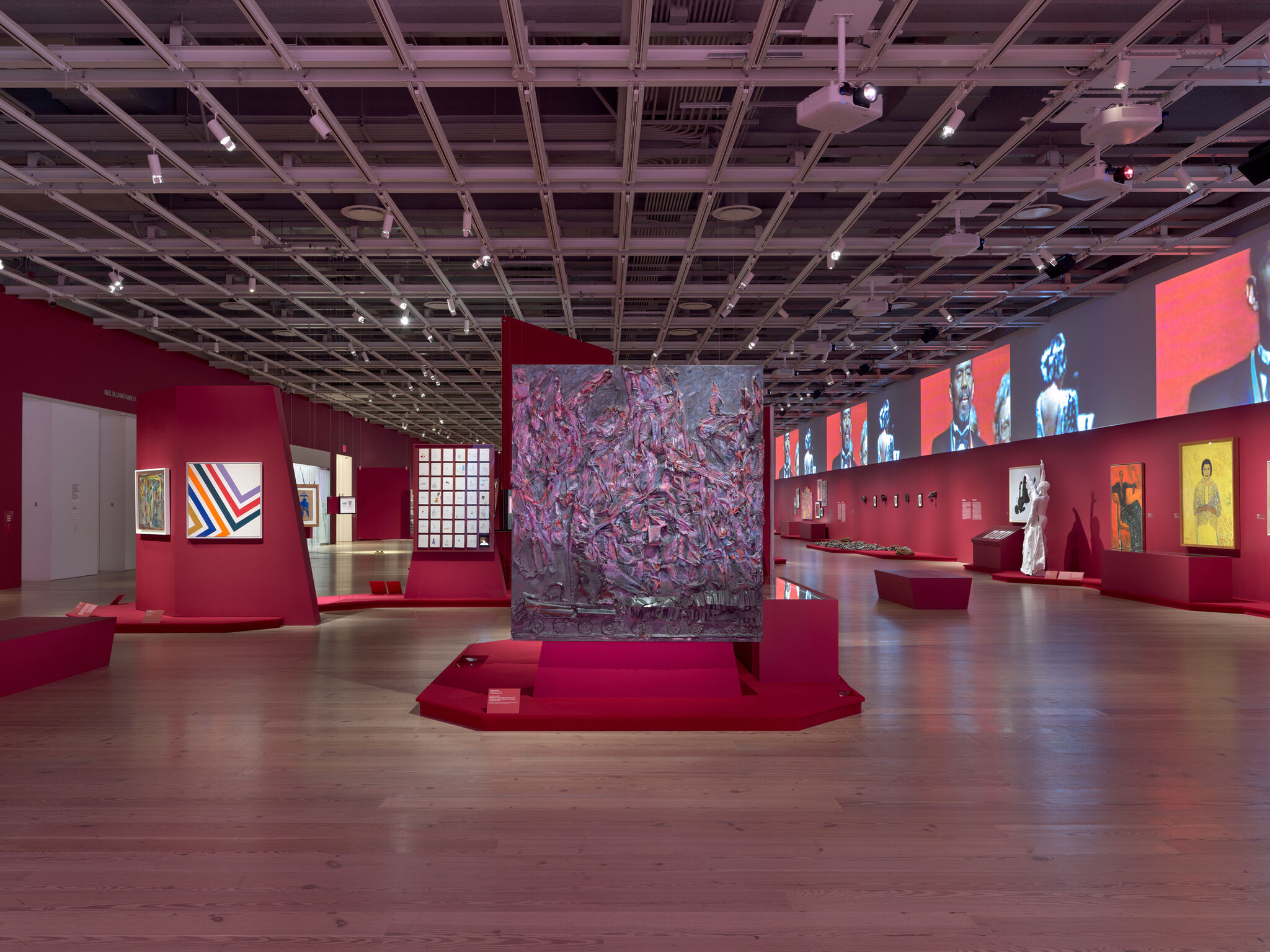

Installation view of Edges of Ailey (Whitney Museum of American Art, New York, September 25, 2024-February 9, 2025). From left to right: Norman Lewis, Phantasy II, 1946; Sam Gilliam, Swing 64, 1964; Bill Traylor, Untitled (Man in a Blue House), date unknown; Ralph Lemon, Bongos and Djembe, 1999; Ralph Lemon, Untitled (On Black music), 2001-07; Thornton Dial, Soul Train, 2004; Sam Doyle, Frank Capers, 2023; Sam Doyle, LeBe, 1970s; Wadsworth Jarrell, Together We Will Win, 1973; Faith Ringgold, United States of Attica, 1971; Wadsworth Jarrell, Revolutionary (Angela Davis), 1972; James Van Der Zee, Marcus Garvey Rally, 1924; Jeff Donaldson, Soweto/So We Too, 1979; Maren Hassinger, River, 1972/2012; Maren Hassinger, River, 1972/2012; Melvin Edwards, Utonga (Lynch Fragment), 1988; Aaron Douglas, Bravado, 1926; Melvin Edwards, Chitungwiza from the Lynch Fragment series, 1989; Aaron Douglas, Flight, 1926; Melvin Edwards, Katura from the Lynch Fragment series, 1986; Aaron Douglas, Surrender, 1970; Melvin Edwards, Cup of? From the Lynch Fragment series, 1988; In vitrine, from left to right: Elizabeth Catlett, I am the Negro Woman, 1947, printed 1989; Elizabeth Catlett, In Harriet Tubman I helped hundreds to freedom, 1946, printed 1989; Elizabeth Catlett, In Sojourner Truth I fought for the rights of women as well as Negroes, 1947, printed 1989; Elizabeth Catlett, In Phillis Wheatley I proved intellectual equality in the midst of slavery, 1946, printed 1989; From left to right: Kara Walker, African/American, 1998; Karon Davis, Dear Mama, 2024; Geoffrey Holder, Portrait of Carmen de Lavallade, 1976; Beauford Delaney, Marian Anderson, 1965; Loïs Mailou Jones, Jennie, 1943. Photograph by Ron Amstutz
From the exhibition Edges of Ailey
-
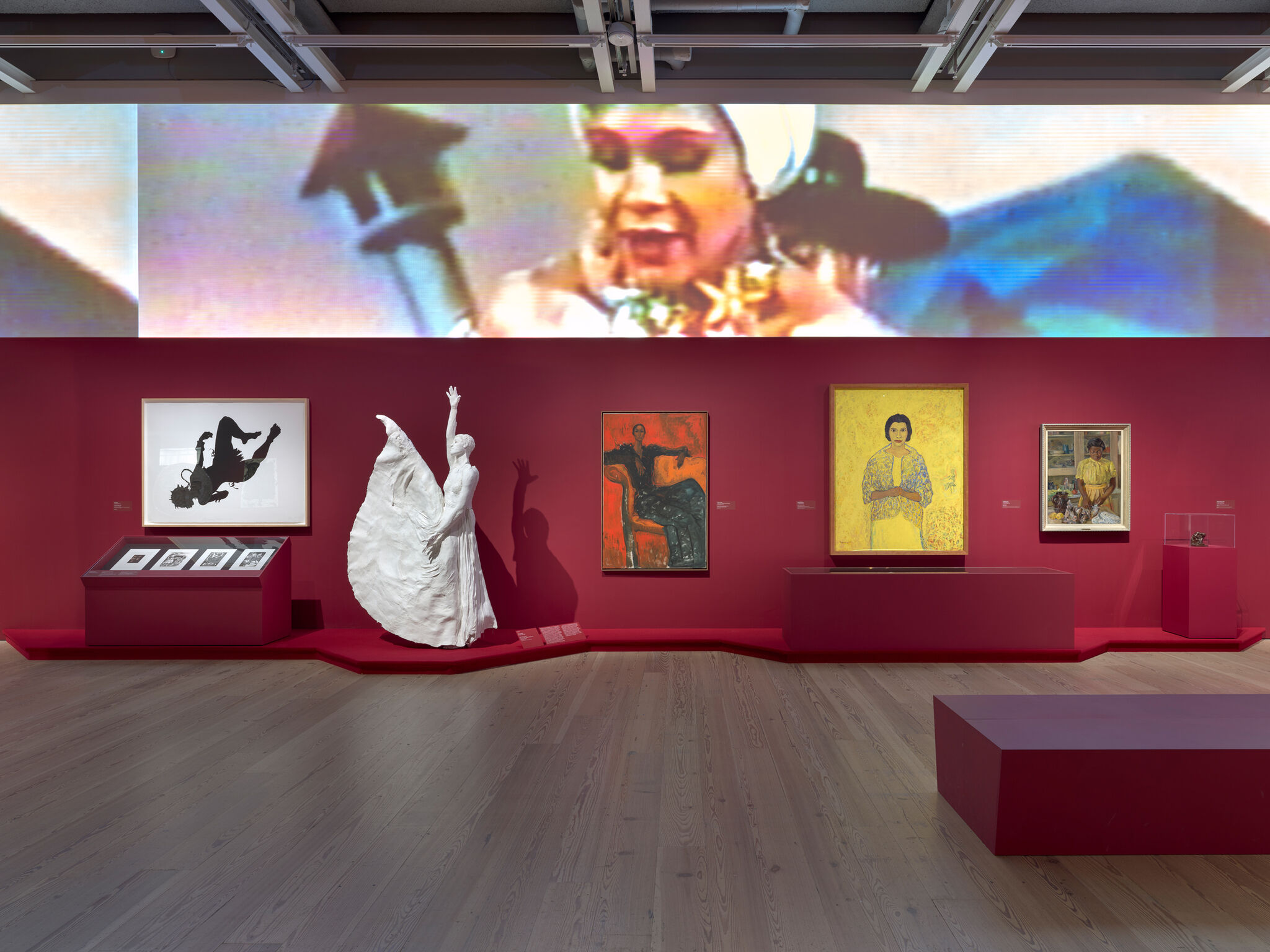

Installation view of Edges of Ailey (Whitney Museum of American Art, New York, September 25, 2024-February 9, 2025). In vitrine, from left to right: Elizabeth Catlett, I am the Negro Woman, 1947, printed 1989; Elizabeth Catlett, In Harriet Tubman I helped hundreds to freedom, 1946, printed 1989; Elizabeth Catlett, In Sojourner Truth I fought for the rights of women as well as Negroes, 1947, printed 1989; Elizabeth Catlett, In Phillis Wheatley I proved intellectual equality in the midst of slavery, 1946, printed 1989; From left to right: Kara Walker, African/American, 1998; Karon Davis, Dear Mama, 2024; Geoffrey Holder, Portrait of Carmen de Lavallade, 1976; Beauford Delaney, Marian Anderson, 1965; Loïs Mailou Jones, Jennie, 1943; Meta Vaux Warrick Fuller, Mother and Child (Secret Sorrow), c. 1914. Photograph by Ron Amstutz
From the exhibition Edges of Ailey
See also
-
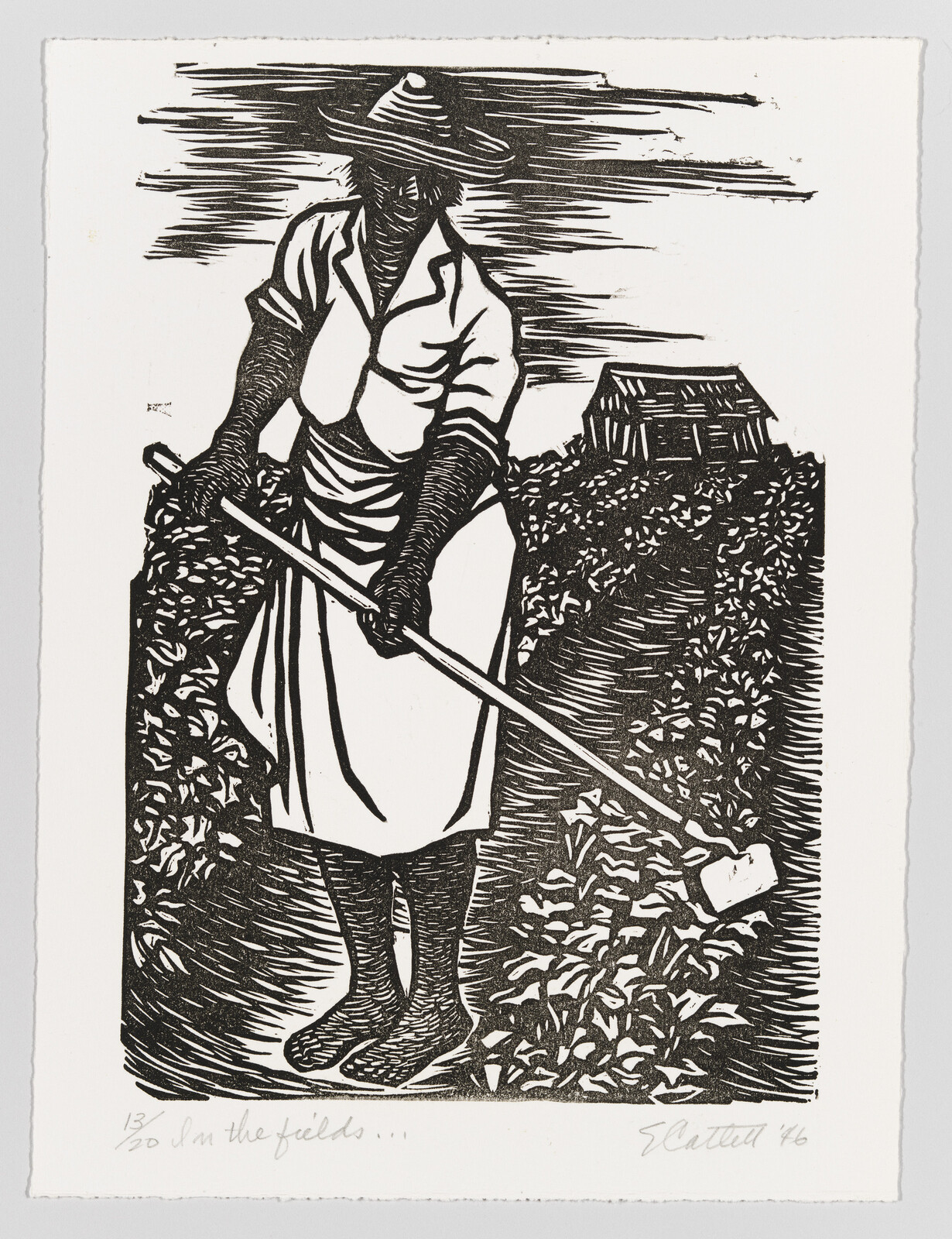
Elizabeth Catlett
In the fields...
1946, printed 1989 -
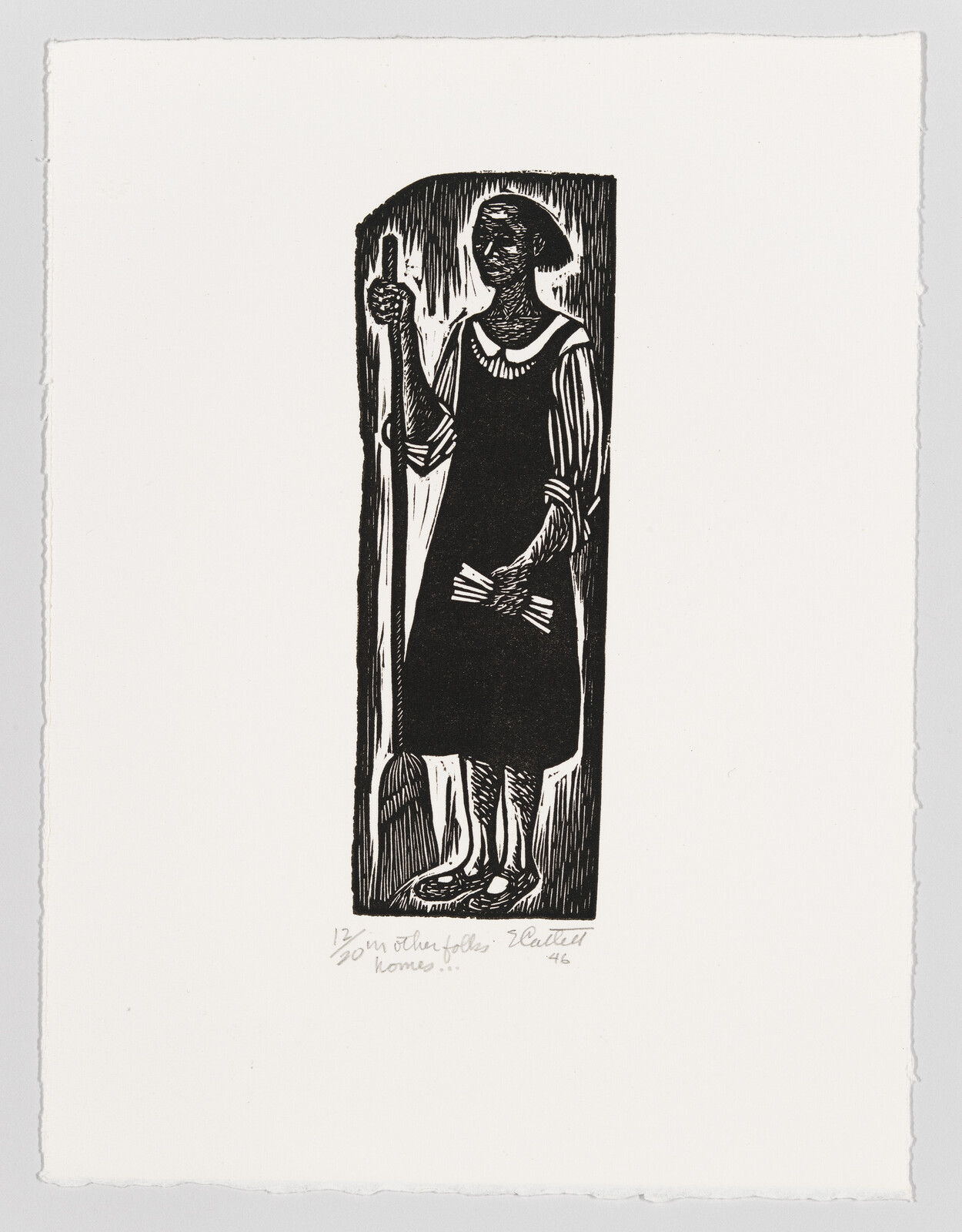
Elizabeth Catlett
In other folks' homes...
1946, printed 1989 -
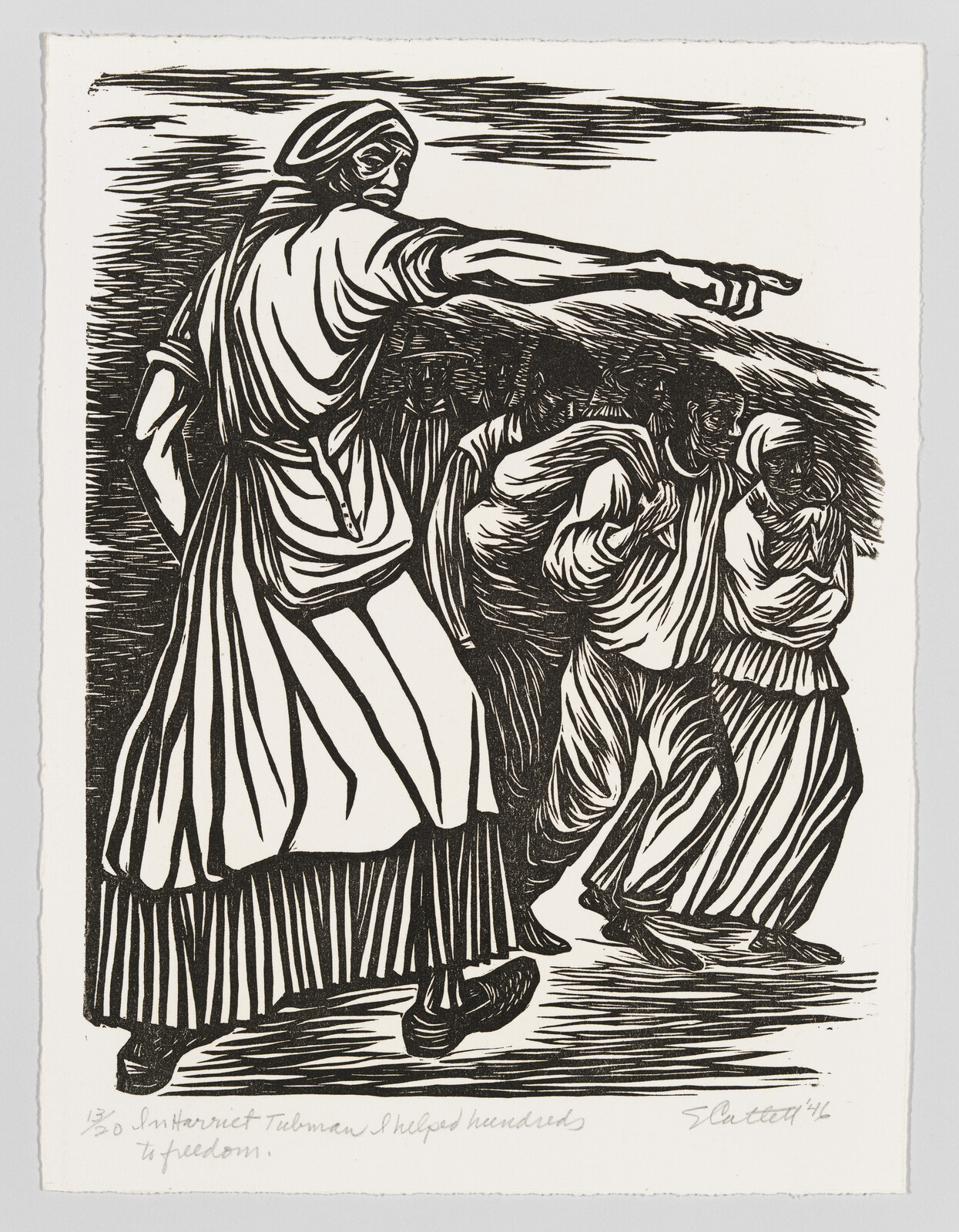
Elizabeth Catlett
In Harriet Tubman I helped hundreds to freedom
1946, printed 1989 -
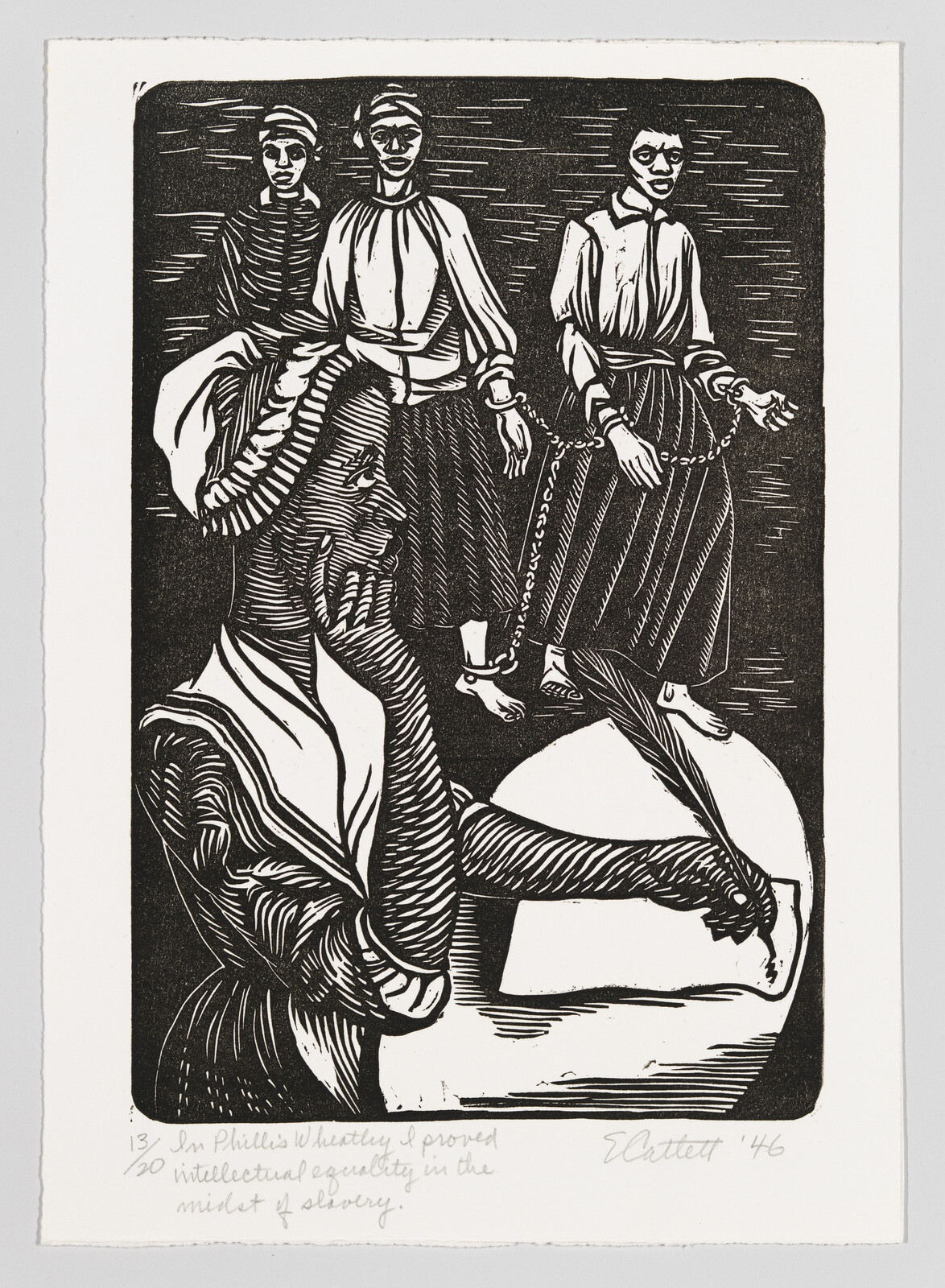
Elizabeth Catlett
In Phillis Wheatley I proved intellectual equality in the midst of slavery
1946, printed 1989 -
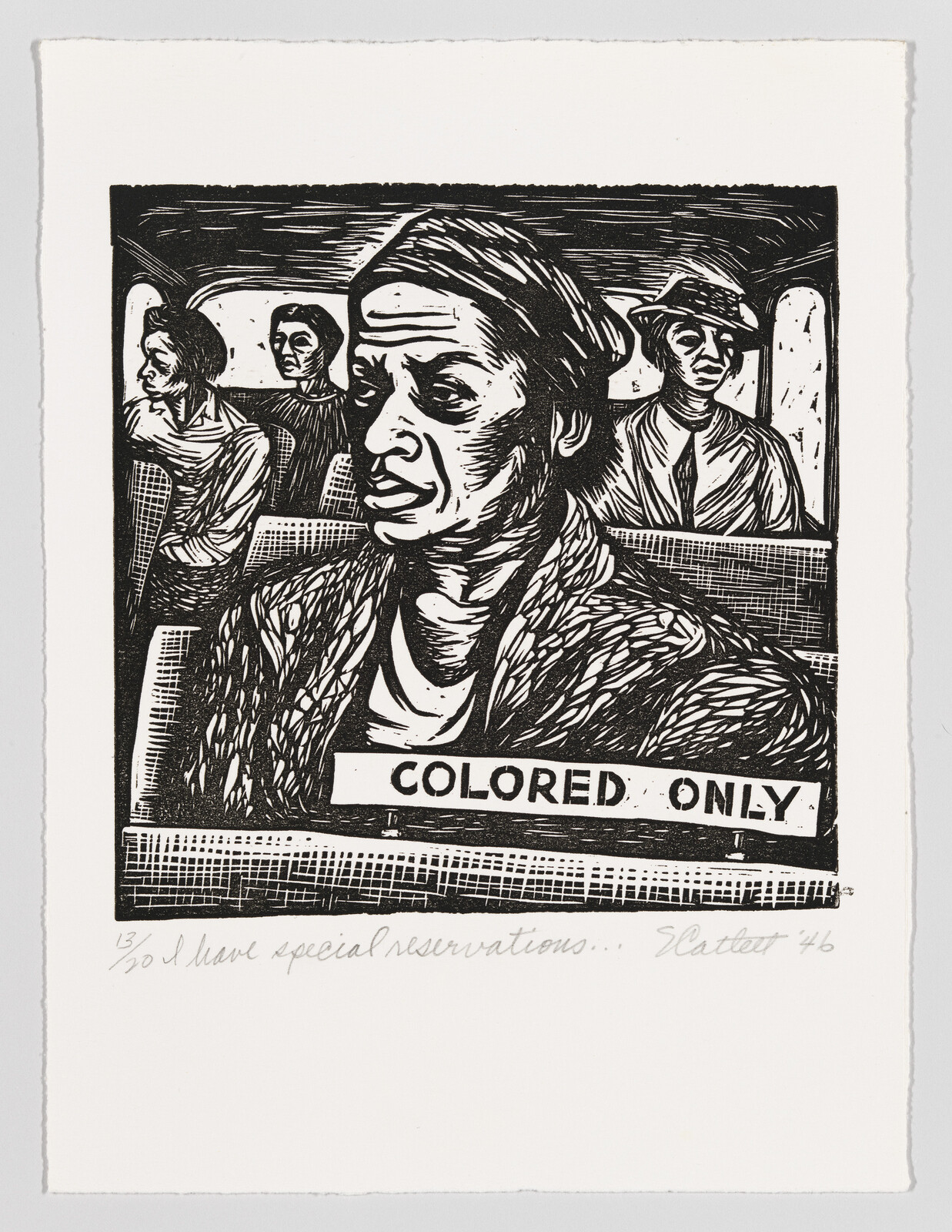
Elizabeth Catlett
I have special reservations...
1946, printed 1989 -
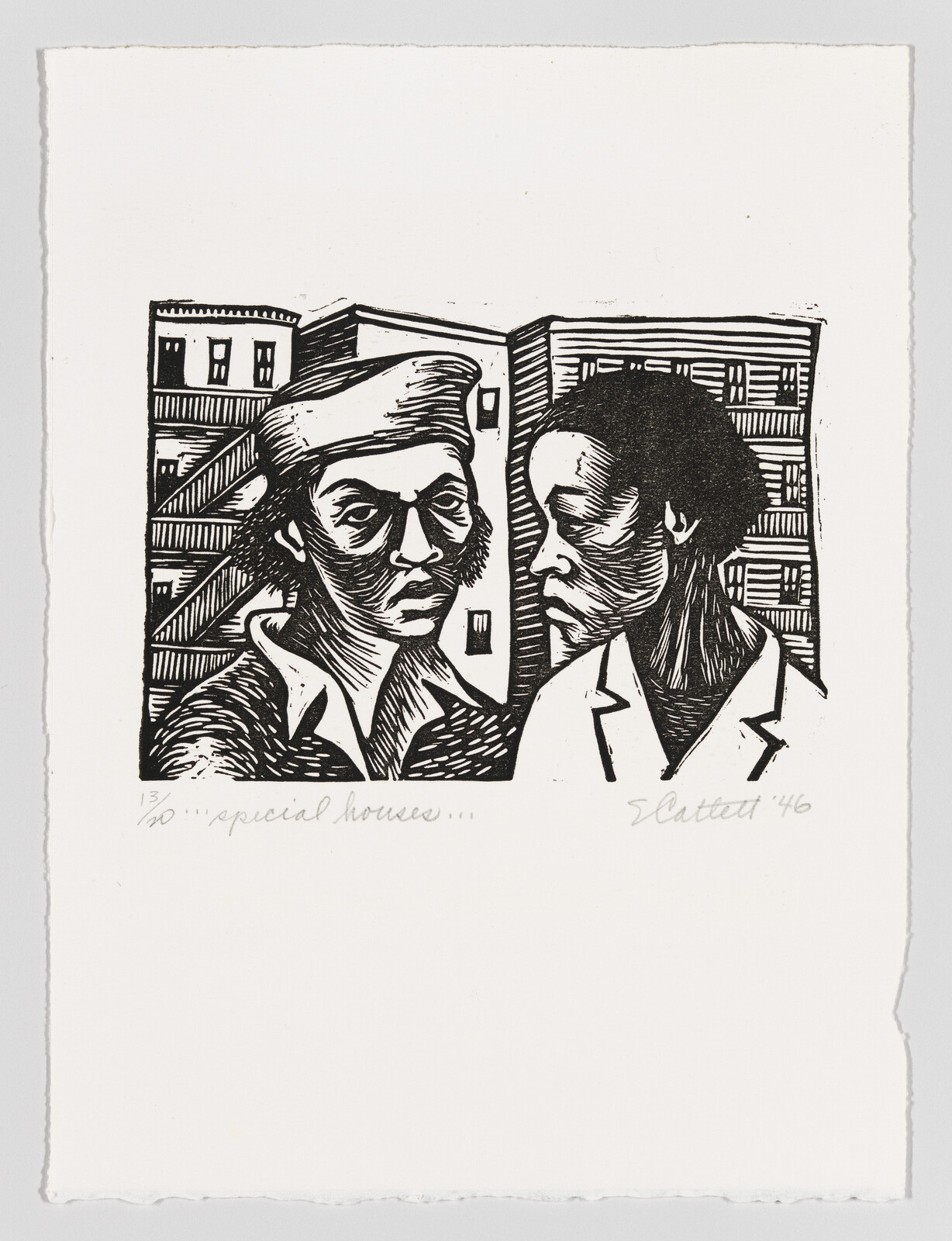
Elizabeth Catlett
...special houses...
1946, printed 1989 -
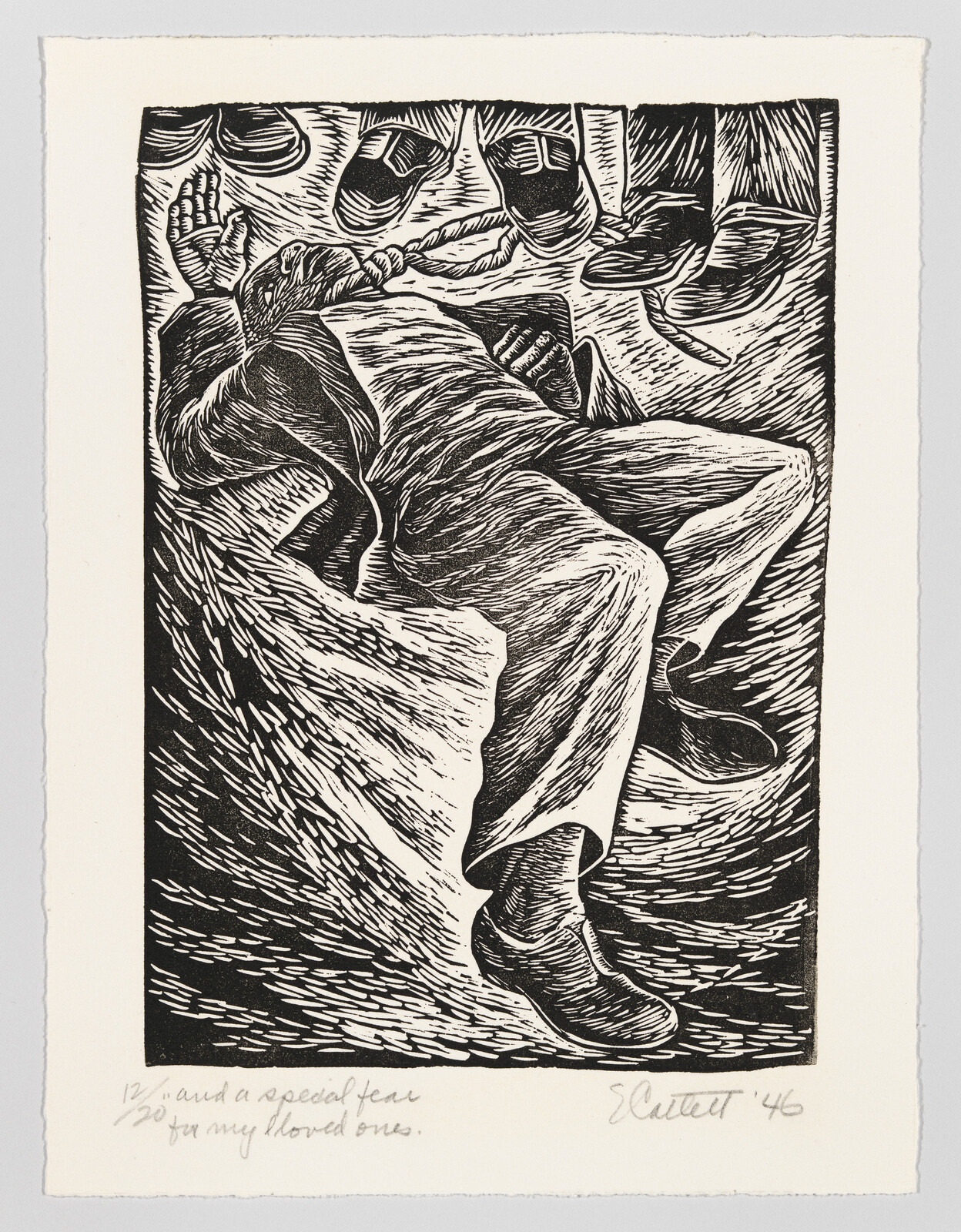
Elizabeth Catlett
..and a special fear for my loved ones
1946, printed 1989 -
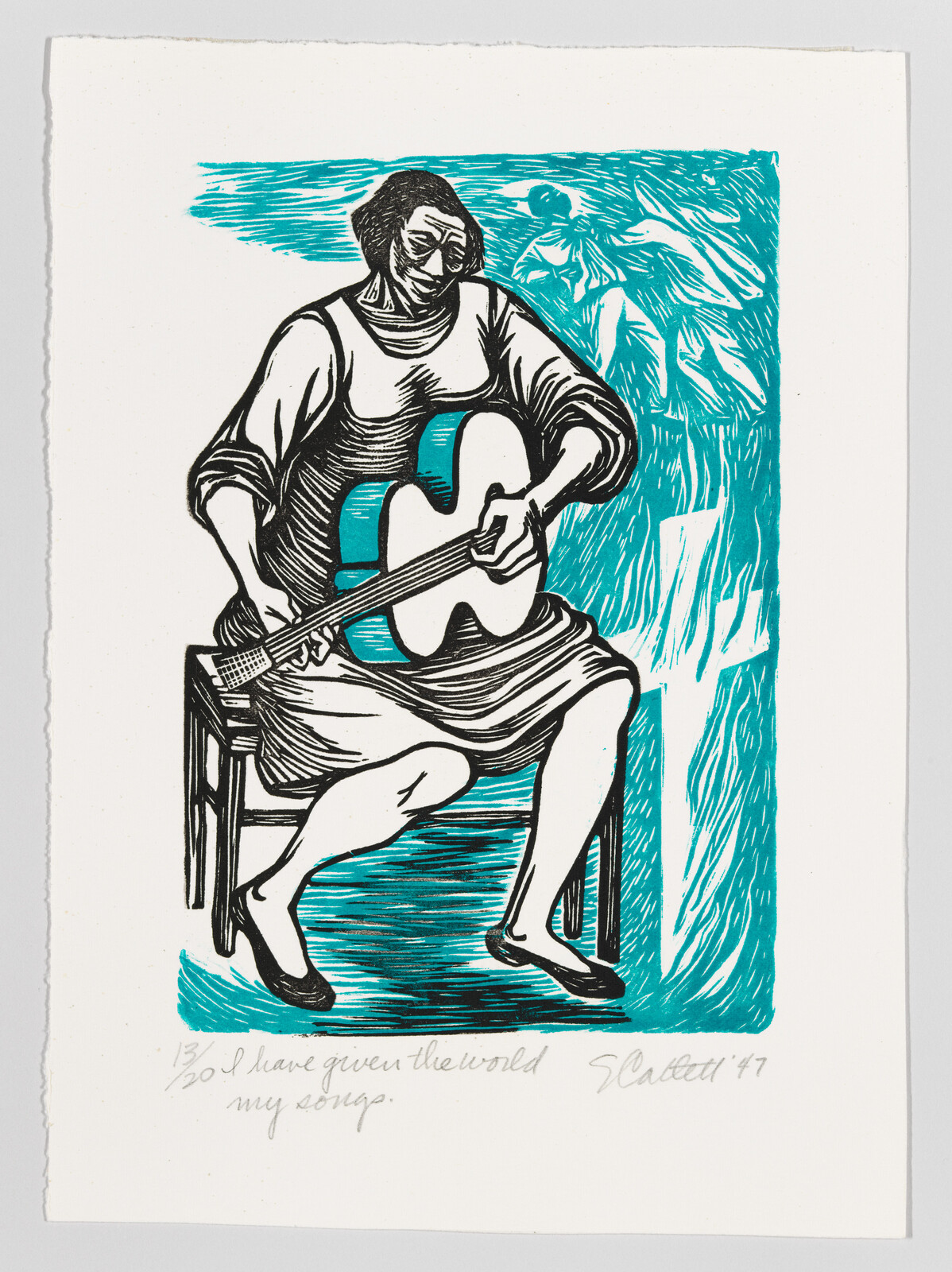
Elizabeth Catlett
I have given the world my songs
1947, printed 1989 -
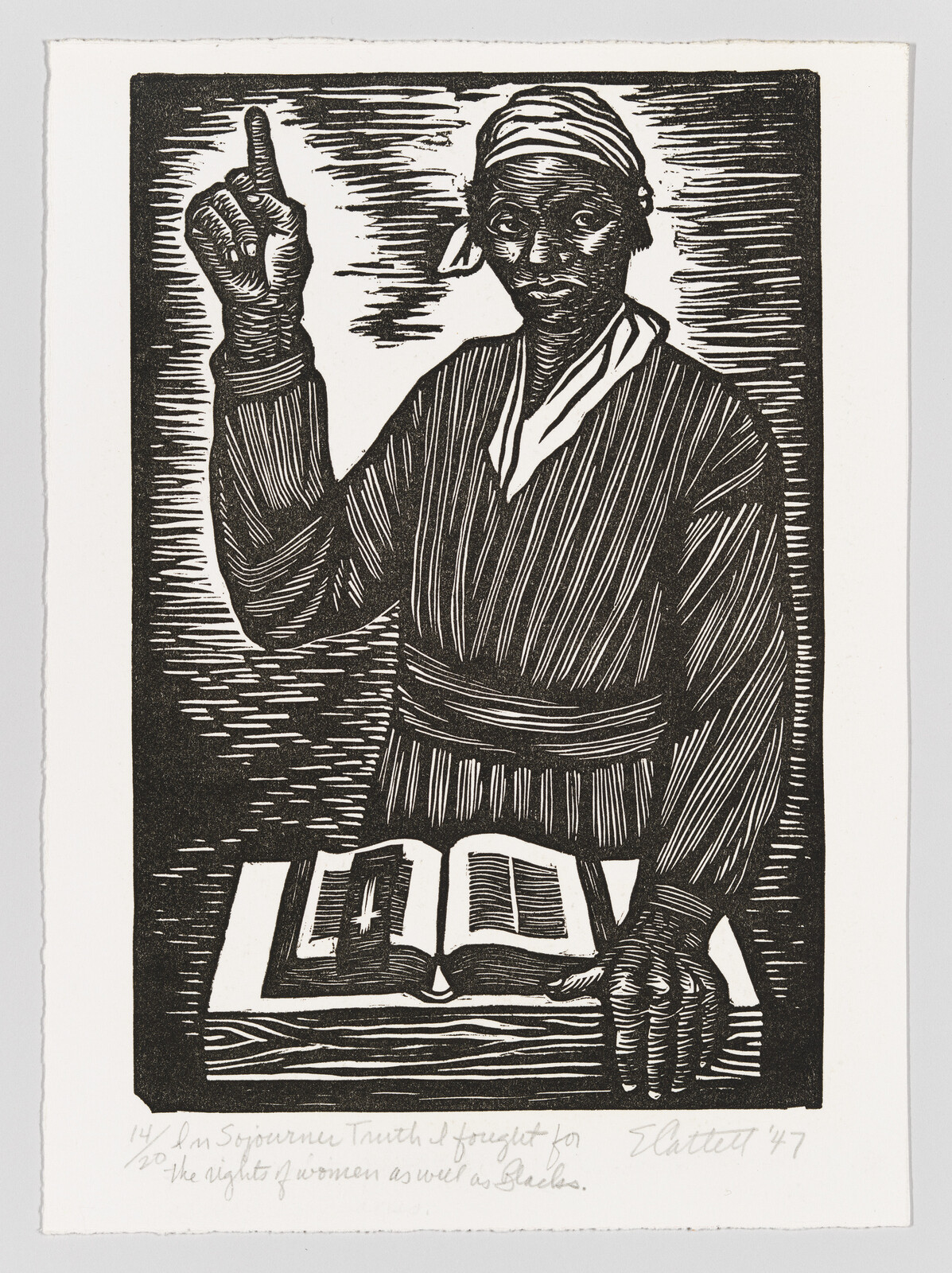
Elizabeth Catlett
In Sojourner Truth I fought for the rights of women as well as Negroes
1947, printed 1989 -
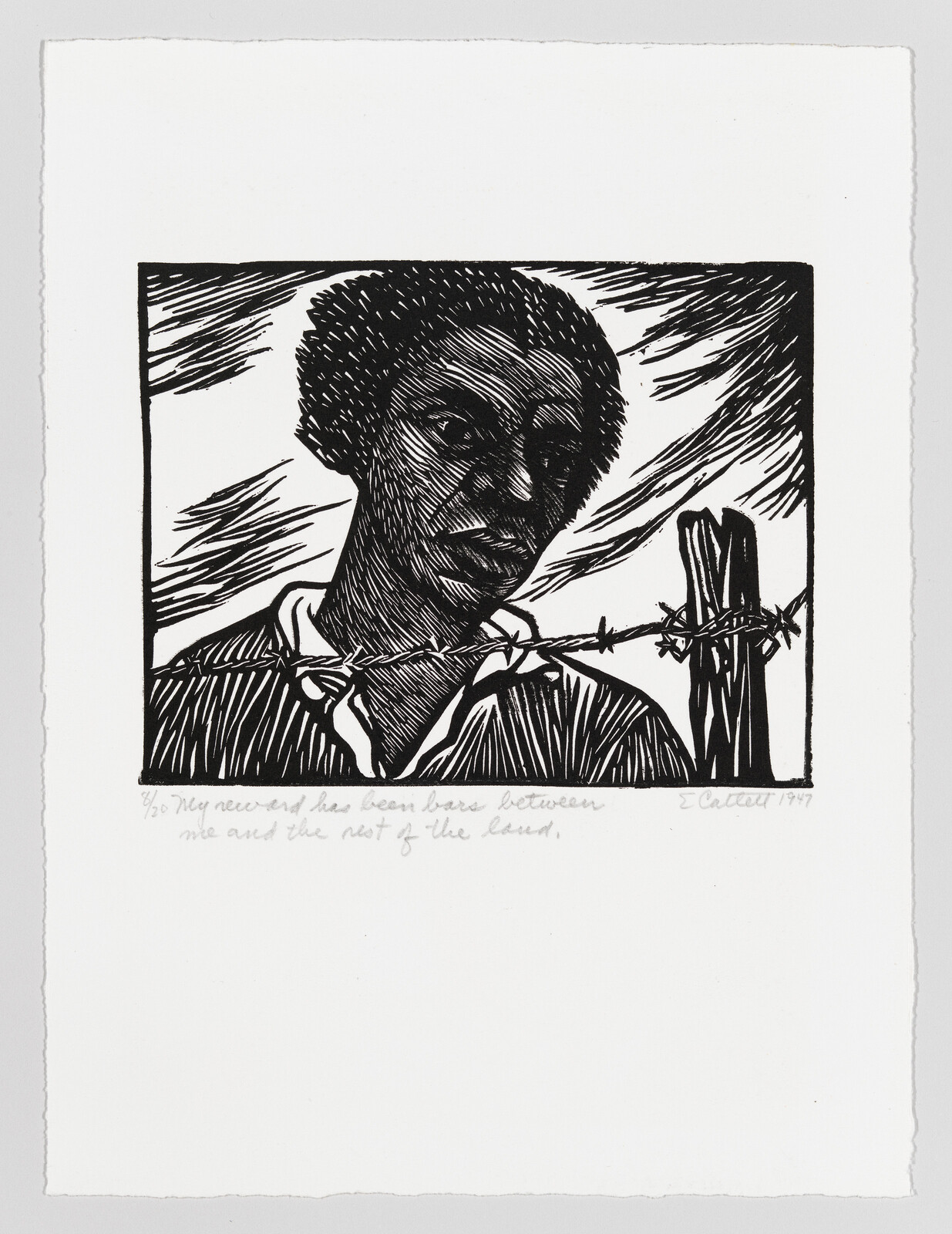
Elizabeth Catlett
My reward has been bars between me and the rest of the land
1947, printed 1989 -
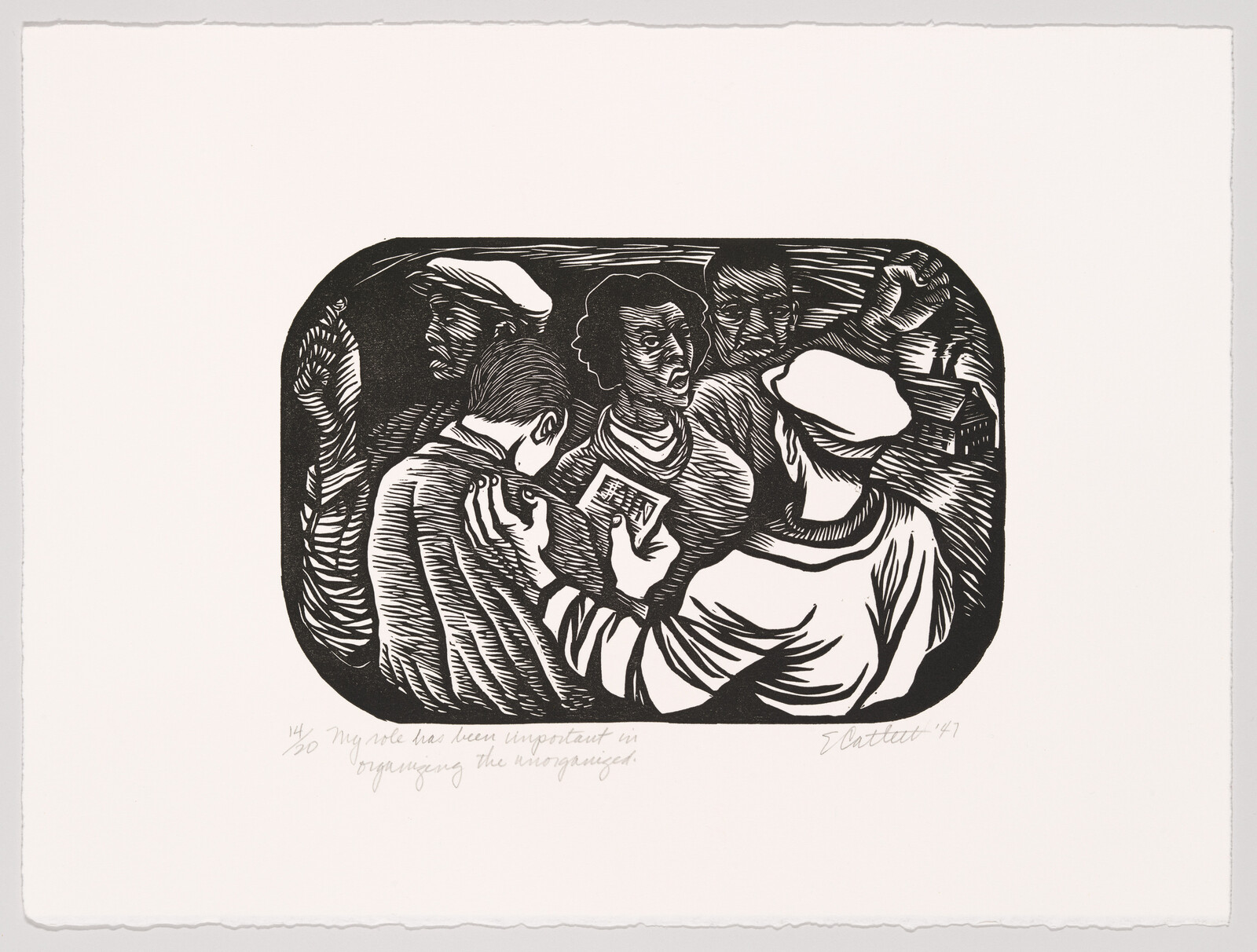
Elizabeth Catlett
My role has been important in organizing the unorganized
1947, printed 1989 -
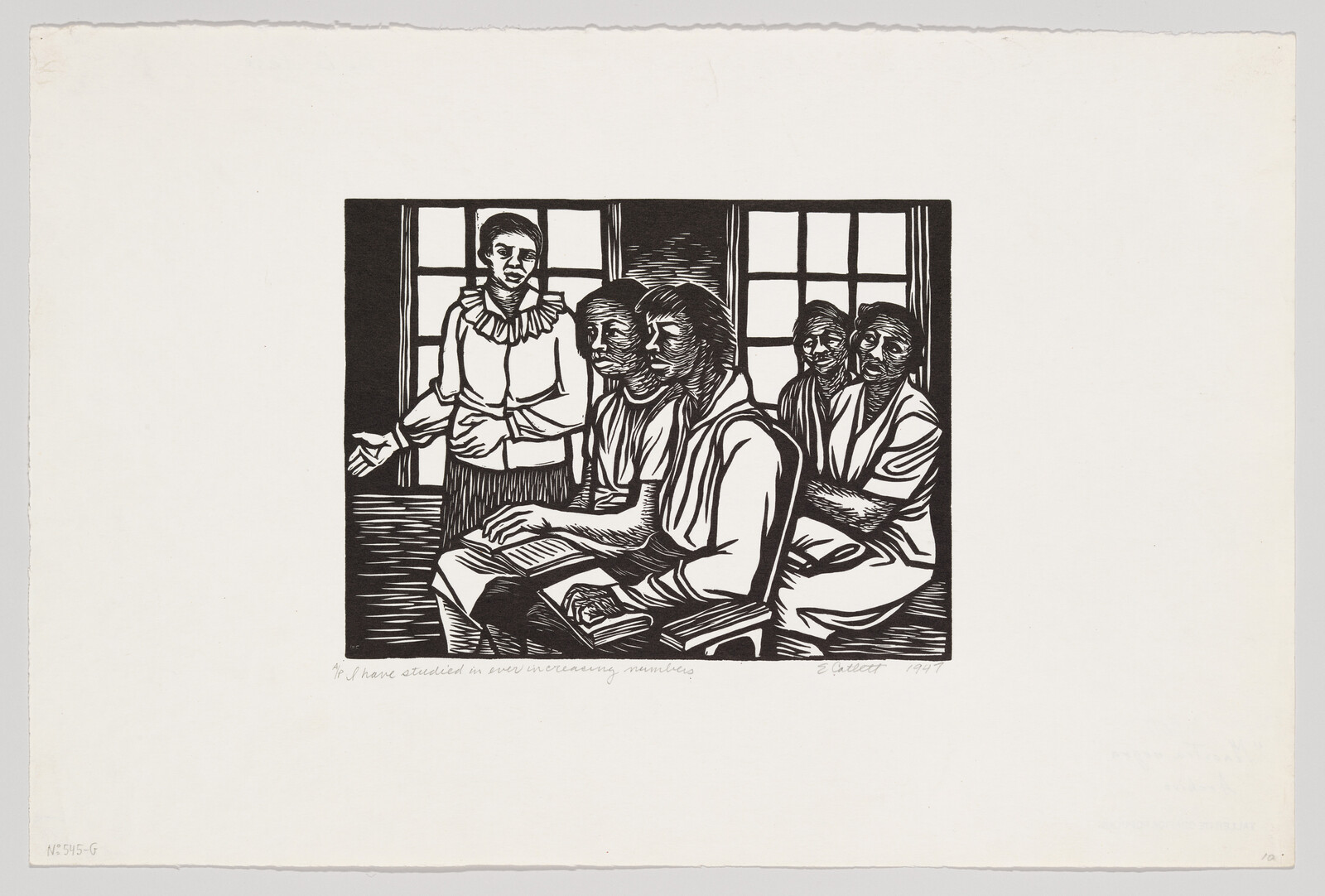
Elizabeth Catlett
I have studied in ever increasing numbers
1947 -
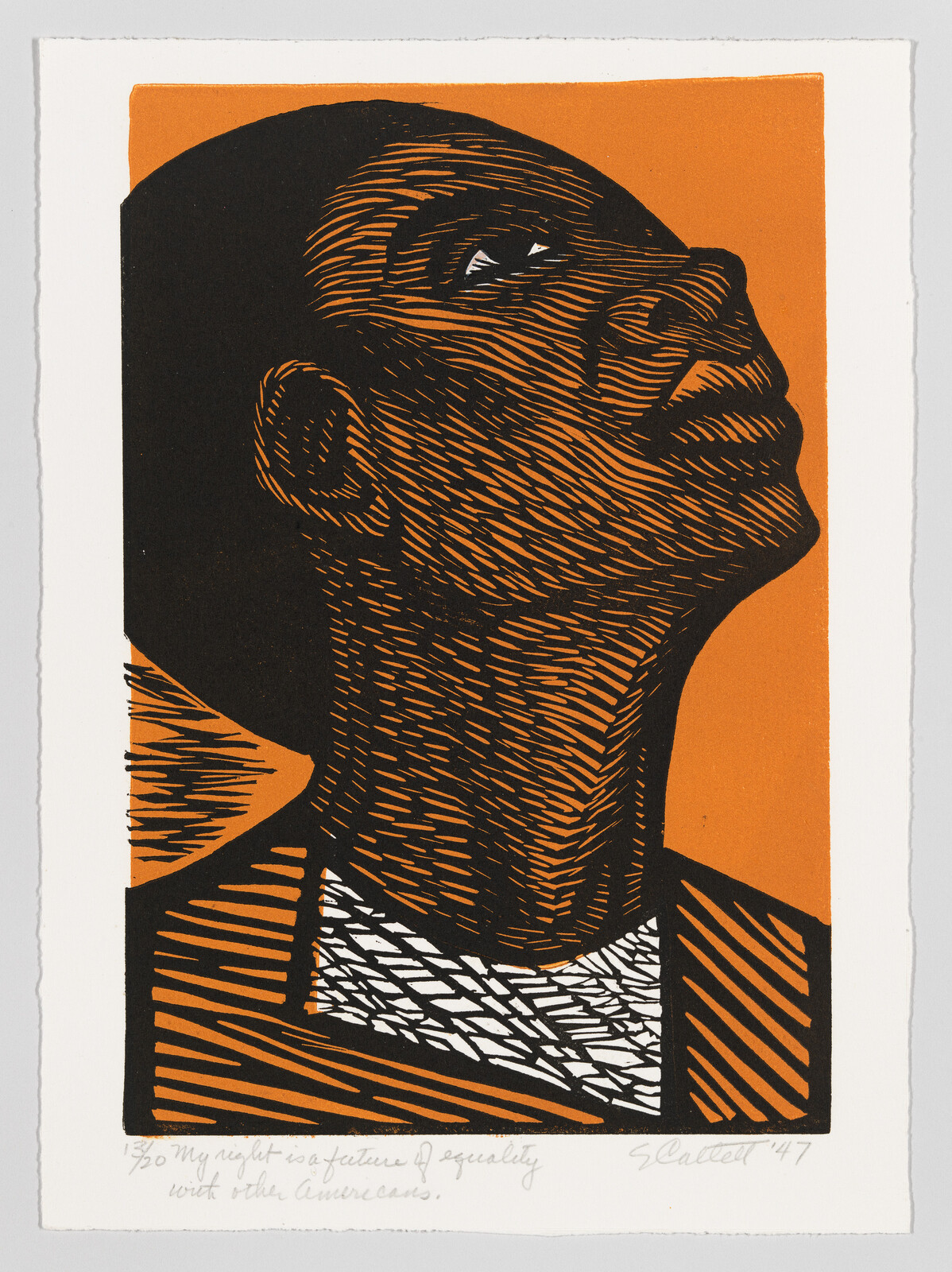
Elizabeth Catlett
My right is a future of equality with other Americans
1947, printed 1989 -
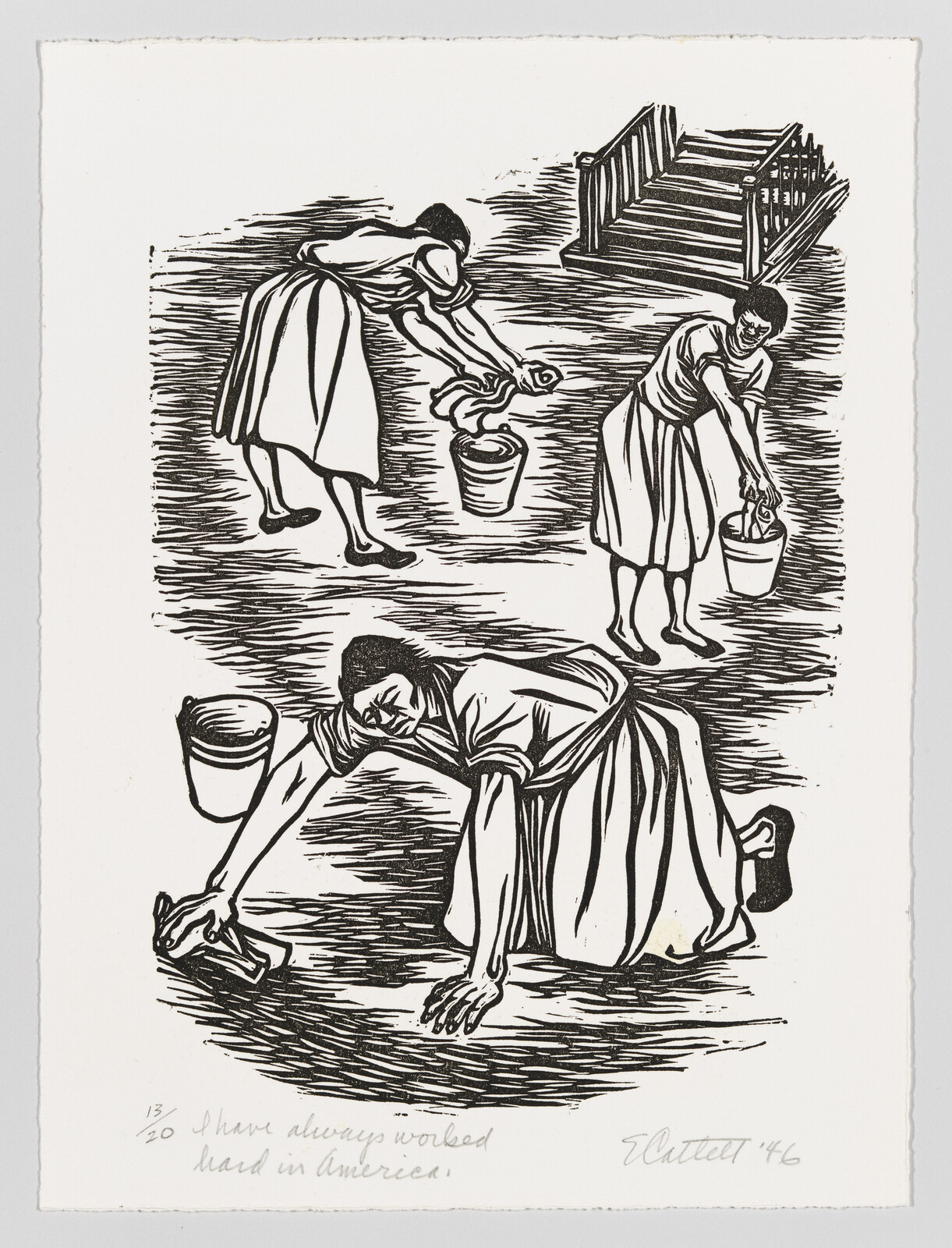
Elizabeth Catlett
I have always worked hard in America
1946, printed 1989

